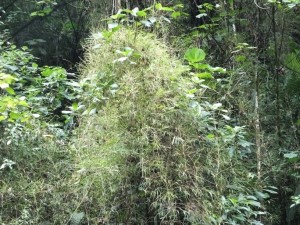Last weekend, I guided a Birding Club of Costa Rica trip to the Los Campesinos Ecolodge. This site is one of several rural tourism initiatives in Costa Rica, and like most, provides somewhat basic yet good service and food in a setting surrounded by green space. The birding at these sites varies in terms of “quality” birds (“quality” being synonymous with large areas of mature forest) but it’s always nice (“nice” meaning that you will see a bunch of birds, and different ones every day).
Some information about birding at Campesinos:
Nice views: With the cabins situated on a ridge between streams, you have a fair view of a couple of forested hillsides. The distant trees are the perfect opportunity to make use of that scope that you almost didn’t bring to Costa Rica. We saw Golden-naped Woodpeckers, a few raptor species, tityras, and other expected birds. Other species are of course also possible, maybe even Turquoise Cotinga. It does live in the area after all. The ridge-top location also allows views into much closer crowns of trees. Our hoped for mixed flocks at eye level never showed but could certainly happen, and we did have nice looks at Olivaceous Piculet (common there), Eye-ringed Flatbill, Blue Dacnis, Long-billed Starthroat, and other species.
This Eye-ringed Flatbill was very cooperative.
Secondary forest:Although there is some older growth along the stream, it seemed like most forest around the ecolodge was secondary in nature. There are still plenty of birds but that type of forest doesn’t usually have as many raptors and many species as older rainforest. That said, we had some nice species indicative of older forest anyways including a Striped Woodhaunter that entertained us with its ringing calls all day long, Tawny-crowned Greenlet, Sulphur-rumped Flycatcher, Red-capped Manakin, Golden-crowned Spadebill, Tawny-winged Woodcreeper, and Scaly-throated Leaftosser. These were all on the trails that went down to the streams.
The view from the cabins.
Mature forest on the road up: Although the birding is OK at the ecolodge, I suspect that it is much better on the drive up. Sadly, we didn’t get a chance to bird along the road but the habitat looked really good with lots of huge trees, and streams. I really want to survey that road and would expect such species as White-tipped Sicklebill, Blue-crowned Manakin, various woodcreepers, trogons, and various other forest-based species (I did hear White-throated Shrike-Tanager and Rufous Piha from the car…).
Swifts: As in this seems to be a good place to watch them. In addition to White-collared and Costa Rican Swifts, we also had Lesser Swallow-tailed, Chestnut-collared, and at least one likely Spot-fronted. It was a tail view of a silent bird but it wasn’t a Chaetura and flew different from White-collared and Chestnut-collared.
Trails:There are a couple, one going up a hill and the other going down to the base of a beautiful waterfall. The one going up the hill passes through nice forest along a stream for a bit before making a steep ascent. We didn’t do that ascent but had some nice species near the stream (the ones mentioned above). The other trail goes through thick, viney forest for a short ways. The rest of the birding we did was on the entrance road to the lodge. That was fine with several second growth species and some canopy birds including Rufous-breasted and Black-bellied Wrens (Riverside is everywhere), Cocoa Woodcreeper, Olivaceous Piculet, and others.
There is also a long, bridge to the waterfall.
The road there: The road to Londres is pretty good but once you get past there, you really need four wheel drive. During really heavy rains, I could see that road being impassible. The challenging part of the drive up also coincides with the best habitat.
Accommodating:The ecolodge was very accommodating and were willing to make us coffee at dawn. Since we didn’t want them to have to come all the way up there at dawn just to make us coffee (we didn’t schedule breakfast until 8:30), we asked them to make coffee the evening before and leave it in a thermos along with cups. They did just that, always served good, home-cooked food, and were always attentive to our needs. Rooms were also clean and were equipped with fans.
One of the cabins.
This site would be a good day visit from the Manuel Antonio area, especially the mature forest on the road up. I suspect that the views over forest are better in the Esquipulas area but it would be interesting to see what could be found on the road to Campesinos. Whether visiting either site, Johan Chaves would be one of the guides to go with from the Manuel Antonio area. See my eBird list from Saturday at Campesinos.
















